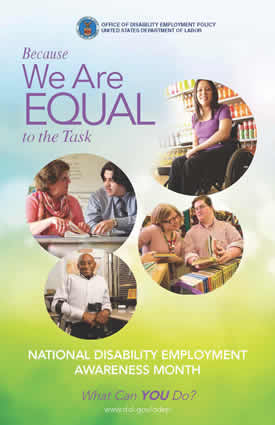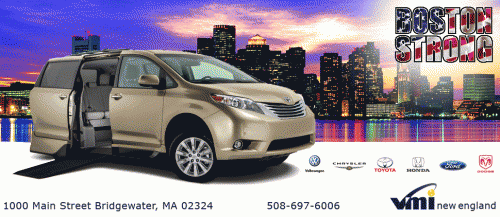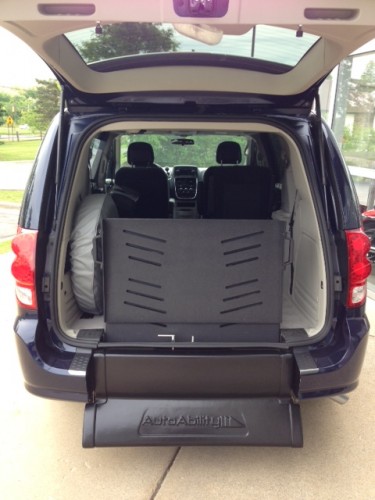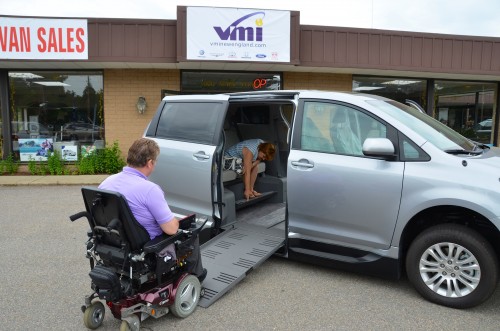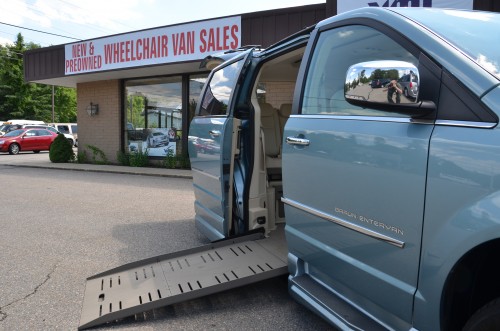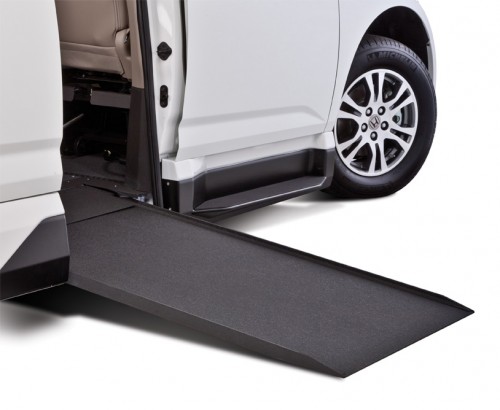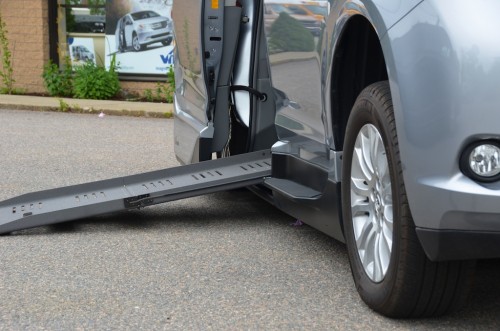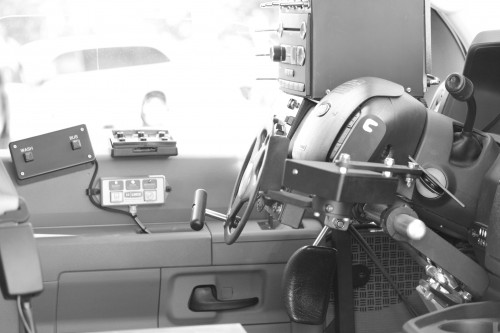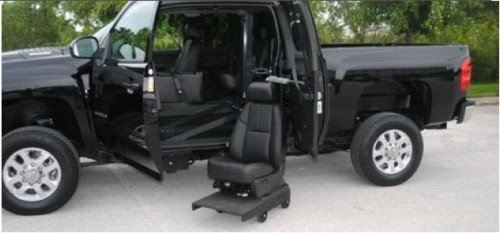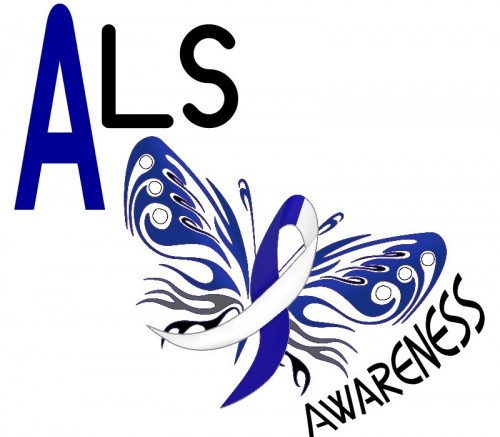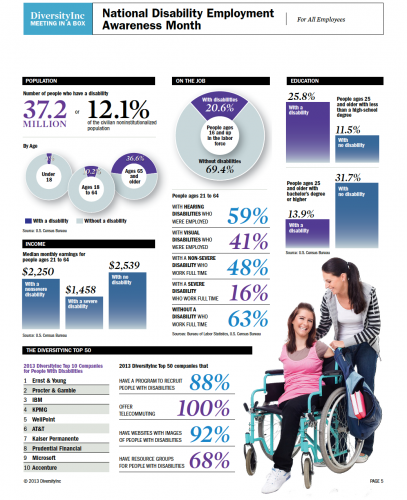 Held each October, Disability Employment Awareness Month is a national campaign that raises awareness about disability employment issues. The opportunity to earn a living and be self-supporting is a broadly held goal by Americans. Work is a foundation of stability for individuals and can give one’s life meaning and purpose. Unfortunately, the rate and level of employment for people with disabilities is staggeringly low. Labor force participation is 22% for people with disabilities as compared to 69% for people without disabilities.
Held each October, Disability Employment Awareness Month is a national campaign that raises awareness about disability employment issues. The opportunity to earn a living and be self-supporting is a broadly held goal by Americans. Work is a foundation of stability for individuals and can give one’s life meaning and purpose. Unfortunately, the rate and level of employment for people with disabilities is staggeringly low. Labor force participation is 22% for people with disabilities as compared to 69% for people without disabilities.
Tag Archives: ALS
National Disability Employment Awareness Month 2013
Because We Are EQUAL to the Task
Held each October, National Disability Employment Awareness Month (NDEAM) is a national campaign that raises awareness about disability employment issues and celebrates the many and varied contributions of America’s workers with disabilities. The theme for 2013 is “Because We Are EQUAL to the Task.”
NDEAM’s roots go back to 1945, when Congress enacted a law declaring the first week in October each year “National Employ the Physically Handicapped Week.” In 1962, the word “physically” was removed to acknowledge the employment needs and contributions of individuals with all types of disabilities. In 1988, Congress expanded the week to a month and changed the name to “National Disability Employment Awareness Month.” Upon its establishment in 2001, ODEP assumed responsibility for NDEAM and has worked to expand its reach and scope ever since.
Toyota Sienna wheelchair van Information
As you search for the wheelchair conversion van that best fits your needs, the number of choices available to you today is likely overwhelming. We can help make that choice easier for you. Whether you’re interested in new or used wheelchair vans, VMi New England Mobility Center can assist you every step along the way.
Deciding which vehicle manufacturer you should choose is one of the most important steps in the purchasing process. Here’s some useful information about new and used Toyota wheelchair vans that you should consider:
Why Choose A Toyota Wheelchair Van?
As soon as the Toyota Sienna Minivan was available, there was a lot of interest generated in using it as a wheelchair conversion van. The good news for Toyota wheelchair van consumers is that from the start, Toyota was working to make the Sienna available with a low-floor wheelchair conversion.
Toyota recognized the potential to broaden Sienna’s market to individuals who are disabled, as well as to the rapidly growing senior population. As a result, Toyota was proactive in seeking out a U.S.-based wheelchair van conversion company to supply this market. Toyota selected Independent Mobility Systems, Inc. (IMS)—located in Farmington, New Mexico—to be their mobility conversion partner because of IMS’ quality manufacturing capabilities and extensive U.S. dealer network. The result was the 2003 IMS Sienna Rampvan.
Conversion Van Features
IMS was purchased by The Braun Corporation in 2004,
Now manufactured by one of the best and largest wheelchair van supplier in the world, the Toyota Sienna with a Vantage Mobility Northstar Conversion is considered one of the premier Toyota wheelchair vans in the industry. This partnership with Toyota has created new wheelchair van manufacturing techniques and processes that have increased quality and shortened lead times, making VMI Northstar and Summit conversions seem like it’s manufactured directly by Toyota. In addition, VMi New England Mobility Center set’s a higher standard than other mobility dealers in the area.
The following are some of the outstanding features of the Toyota Sienna wheelchair van:
- The Insurance Institute for Highway Safety gave the Sienna the highest possible front and side impact crash test ratings.
- The American Council for an Energy-Efficient Economy voted the Sienna the “greenest minivan” for its ultra-low emissions and high fuel efficiency.
By combining the Toyota Sienna with Vmi New England’s superior upgrades to the wheelchair conversion process, the Northstar rampvan provides among the safest, most comfortable Toyota handicap vans available today.
More Choices for Toyota Wheelchair Conversion Vans
While Vantage Mobility has been focusing on Side-Entry, Automatic Wheelchair conversions for the Toyota Sienna, other companies have been building Rear Entry Wheelchair Van Conversion with a Manual ramp and door. Some companies have always been exclusively focused on the rear-entry market and their customers were asking for product on the Toyota Sienna platform.
Some people prefer a rear entry wheelchair van because of their parking situation, the environment in which they drive or their budget. With a VMi New England Mobility Center Toyota Sienna, these wheelchair van consumers now have all the benefits of a rear-entry wheelchair conversion van on the Toyota Sienna that they desire.
Models Available for Your Toyota Handicap Conversion Van
Toyota offers 4 Sienna models, and all of them can be converted into a wheelchair accessible minivan:
- CE: Toyota quality for the budget conscious consumer
- LE: Familiy value with additional option packages
- XLE: Well appointed with many standard options included and many more available.
- Limited: Includes luxury appointments and standard options for those that desire the finest Toyota Sienna available.
Toyota Models Typically in Inventory
VMi New England Mobility Center works very hard to make sure that we have the Toyota handicap vans that you want in our inventory at our Bridgewater facility. This allows you ample opportunity to see, and drive them and they are available for immediate delivery.
The Toyota Sienna LE and Toyota Sienna XLE are, by far, the most popular models with our customers and we do our best to have these in stock in colors that will please the majority of wheelchair van consumers. For wheelchair van buyers who are seeking the low cost of the Toyota Sienna CE or desire the added features and luxury of the Toyota Sienna XLE, we can place special orders or draw from the inventory of other Mobility Centers across the country.
Depending on availability, we can usually have the exact Toyota handicap van you are looking for within as little as three days.
Toyota Wheelchair Van Conversion Specifications
See the following table for the various conversion options we make available to you for the Toyota Sienna Minivan:
| Mobility Conversion Style | Product | Manual/Automatic |
|---|---|---|
| Rear-Entry Wheelchair Ramp | Toyota Sienna | Manual Ramp |
| Side-Entry Fold-up Wheelchair Ramp | Toyota Sienna Summit | Automatic/Power Ramp and Door Conversion Only |
| Side-Entry In-Floor Wheelchair Ramp | Toyota Sienna Northstar | Automatic/Power Ramp and Door Conversion Only |
We are the oldest NMEDA Quality Assured Dealer in MA
We are your local mobility fitment center offering you the best Lowered Floor vans available. We have been the leader in Custom Handicap van fitment for decades in the New England area including the Toyota Sienna, Honda Odyssey, Dodge Caravan and Chrysler Town & Country power or manual side entry and power or manual rear entry.
adaptive mobility equipment installations are no problem.
Call us for Veterans resources or to find out more about our FREE to Veterans maintenance program.
We are minutes from Providence RI, not far from Warwick RI, very close to Fall River MA, a short drive from Boston MA, right up the road from Cape Cod MA, in the back yard of Plymouth MA , 20 minutes from Attleboro MA, 45 minutes from Worcester MA, a little farther from Springfield, MA, a short boat ride from Mystic CT, and a short helicopter flight from New Haven CT (call ahead of time if you need space to land your helicopter). Call 506-697-6006 for more info.
Wheelchair vans MA for sales and service. Wheelchair vans RI, MA, CT, NH, VT, ME
Declare Your Independence on the 4th of July with a Wheelchair-Accessible Vehicle
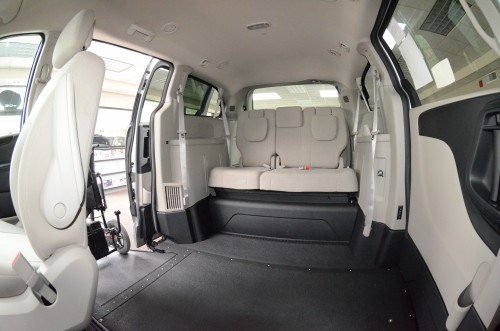
- Learn more about how to pick the right wheelchair-accessible vehicle that meets your needs.
- Take a look inside the latest minivans, and other accessible vehicles like a pickup truck, motorcycle or snowmobile.
- Buy new? Buy used? Convert your current vehicle? Here, we provide some factors to consider before making your decision.
Freedom. That’s what it’s all about, isn’t it? A wheelchair shouldn’t be a barrier to getting out and about, whether for work, day-to-day living or pleasure.
“we will always do all we can to deliver the driving freedom most take for granted to someone in a wheelchair, we are going to change the world one person on at a time” , -Jim Sanders 7/4/1988
Finding the right vehicle means analyzing your needs. Do you want to ride in your wheelchair or transfer to the vehicle’s seat? Will you be the driver or the passenger? If your muscle weakness is still progressing, how will your accessibility needs change down the line — and how can you accommodate them now?
What kind of vehicle do you want: car, minivan, van, truck, SUV or motorcycle? New or used? After-market conversion or built for accessibility from the start? Side or rear entry?
A great place to start answering questions is at the website for Vmi New England
The website is a treasure trove of tips for finding the right vehicle.
| For an in-depth look into the life of Ralph Braun, founder and CEO of The Braun Corporation, read CEO with SMA Brings Mobility to All . Learn how he turned his scooter and modified van designs into a multimillion-dollar business — all while battling spinal muscular atrophy. |
Of course, in purchasing a vehicle, monetary concerns always come into play. The New England Mobility Center site offers various directions to take in finding government funding and public assistance. You’ll also find tips on buying auto insurance, numerous blogs on accessible-vehicle-related subjects and info on many travel accessories to make life easier on the road.
Because of the tremendous number of variables in the custom fitment for each persons specific needs, it’s not possible to give exact prices for the minivans featured. However, we can provide some figures that will give you a ballpark idea of accessible vehicle pricing.
- New side-entry converted minivans range from around $48,000 to $75,000.
- New rear-entry converted minivans with manually operated fold-out ramps start in the low $40,000s.
- You can find 3-year-old minivans with brand-new conversions starting in the low $30,000s.
For those with severe muscle weakness who want to drive their vehicle themselves, certified driver rehabilitation specialists (CDRS) can evaluate your needs at the Bridgewater, MA Mobility Center, and provide a prescription for adapted driving equipment and driver training. (For more on this topic, contact us at 508-697-6006).
As you’ll discover, the scope of accessible vehicles is very broad indeed. Here’s a sampler of the myriad options currently available in the world of wheelchair-accessible vehicles and conversion equipment.
| MinivansBraunAbility’s Chrysler Entervan features flexible floor plans For easier boarding, the Entervan has an integrated “kneeling” system; while the door is opening, the rear suspension is lowered, reducing the slope of the ramp. To learn more, call 508-697-6006 .Because wheelchair transportation requirements can change over time, BraunAbility enables buyers to easily configure the floor plan of its Chrysler Entervan. Whether you want to be the driver or the front-seat passenger, removing the appropriate seat is literally a snap: Unlock the seat base and roll the entire seat out of the van. |
|
| VMI’s Honda Odyssey Northstar promotes easy entry
In the side-entry, lowered-floor Honda Odyssey Northstar conversion by VMI, a remote control triggers the PowerKneel System, lowering the vehicle and activating a power ramp that telescopes out from within the interior floor. The lower ramp offers a gentler angle, and the unrestricted entry means better maneuverability once inside. VMI also offers the Summit accessible Toyota van conversion featuring a power fold-out, heavy-duty ramp system with an anti-rattle mechanism. It also has the power kneeling feature. To learn more, call 508-697-6006 . |
|
| Consider a rear entry, says Jim Sanders Although rear-entry vehicles don’t allow wheelchair users to park in the driver or front-passenger locations, Jim’s vision has always been to offer as many options possible including optional swiveling driver or front-passenger seat that may facilitate transferring from the wheelchair. (For more on the rear- versus side-entry question, see them at, the Bridgewater, MA Mobility Center.) To learn more, call 508-697-6006 .Believing that entering and exiting the van through the back sometimes avoids barriers, Our viewpoint and vision has always been to offer as many options as is practical. Rear-entry, lowered-floor modification converts Chrysler, Ford, GM, Honda and Toyota minivans. An automatic remote-control option can even activate the ramp and door. This vision and technology of lowering the vehicle closer to the ground and the ramp to a more comfortable angle for wheelchair access.
|
|
| ‘A mobility concept vehicle’ starts out as a accessible ground up conversion; that can even go green A car or minivan hybrid concept vehicle can be designed custom for you from the ground up with safety and accessibility as its top priority.
|
|
| Rental vehicles New locations are being added, before your next trip or give us a call to learn more at 508-697-6006. It’s may even be possible to rent a Rollx wheelchair-accessible Dodge or Chrysler minivan at selected airports around the country. Someone even told us Thrifty Car Rental, Dollar Rent-a-Car or Payless Car Rental companies were thinking about offer accessible vans at airports like T.F. Green airport 2000 Post Rd, Warwick, RI 02886, Manchester–Boston Regional Airport 1 Airport Rd, Manchester, NH 03103, Logan International Airport 1 Harborside Dr, Boston, MA 02128 | |
| Cars and SUV’s Sport an attitude with a flair for the freedom to have different concept vehicles built with optional Motors depending on your needs a Scion xB might even work.If you’re just not the minivan type, consider the freedom of a concept vehicle, Want a custom sporty wheelchair-accessible vehicle? Click the remote: Simultaneously, the driver’s door swings open, the rear driver-side door gull-wings up and the ramp unfolds, ready for you to maneuver your wheelchair into driving position.
A similar conversion can be configured on the passenger side. Or if rear entry suits your needs, we offer you the freedom to pick a model that work best for you. Prices range from the low $30,000s for a manual rear-entry model to the low $500,000s for a one off concept vehicle with automatic side-entry. To learn more, call 508-697-6006 |
|
| Hand controls and footless driving solutions Systems from mechanical to servo actuated can be installed on most cars with automatic transmissions. The accelerator input can mounted within easy reach of the vehicle’s standard steering wheel, with the controls just inches away on either the right or left. Smoothly accelerate the vehicle remotely without use of your feel, designed to make hands only driving safe and easy.Depending on the make and model of your vehicle, installed prices start around $1,200, additionally we offer transportation of the vehicle to and from our mobility center. To learn more, call 508-697-6006 |
|
Buying used AMS pre-owned van might even be considered.Resale on them is typically incredibly low and these can be a ok deal if your able to bring it to a qualified mobility center to ensure it is in safe and working condition.
There’s no getting around the fact that wheelchair vans are expensive; retrofitting new vans with accessibility equipment doesn’t come cheap. One way to cut costs is to buy a used van to avoid the depreciation that happens when buying new.VMi New England offers many pre-owned vans outfitted with their new conversion equipment which can save buyers as much as $15,000 to $20,000. Or, if you already have a fairly new Chrysler, Dodge or Volkswagen van, they may be able to convert it for you. Rear-entry conversions start at around $13,000, while side-entry conversions start at around $22,000, not including the price of the vehicle. To learn more, call 508-697-6006. There are many grey market conversion vans available to you via the internet, ebay and private parties. Many of these vehicles are being sold by direct marketing companies or individuals who bought them via the internet or ebay only to find out there were many problems with the van, it was unsafe and or wouldn’t work for there needs. So in turn they are for sale again for what appears to be a great deal. I wish i had a dollar for every customer who brought a “internet deal”, “used car dealer van”, “ebay wheelchair van deal” into our facility wanting to know what we could do to make it work for them. Only to hear, i’m very sorry you didn’t visit with us before you purchased this van that your family member or friend in the wheelchair will not fit into the van. |
|
| Motorcycles
When it comes to motorcycles Jim Sanders has and will always promote accessible motorcycles and his personal belief that they offer the ultimate freedom when it comes to travel (unless it’s snowing in which case we need to talk about snowmobiles) If you can operate a manual wheelchair, you may be able to drive a wheelchair-accessible motorcycle, says Sanders. Want a touring bike, a BMW, a KTM or how about a dirt bike. A remote-controlled drop-down ramp at the rear of the vehicle can be up fitted allowing a rider to pull his or her chair into position, secure it with a push-button docking system, and ride off — no transferring necessary.
Bikes featuring a powerful BMW 1170 cc engine, a six-speed, two-button, thumb-operated gear shifter, and a rear-wheel-drive differential can be up fitted . Want a bike with a reverse gear for easier parking and maneuvering? To learn more, call 508-697-6006. If you can operate a manual wheelchair, you maybe able to drive a wheelchair-accessible motorcycle, says Sanders. A remote-controlled drop-down ramp at the rear of the vehicle allows a rider to pull his or her chair into position, secure it with a push-button docking system, and ride off — no transferring necessary. |
|
| SUVs and trucks
A Stow-Away lift puts you inside Bruno doesn’t sell wheelchair-accessible vehicles, but they do offer products that can be up fit into vehicles. Known for their home stair lifts and attachable vehicle lifts for transporting wheelchairs and scooters, they also make an add-on mechanism that may allow you to transfer you from a wheelchair up into the seat of a high-profile SUV or pickup.
|
|
| Ryno no-transfer conversion for pickups
Being a wheelchair user doesn’t mean you have to give up using a pickup truck. VMi New England has been offering pick up truck conversions for over 10 years allowing either driver-side or passenger-side entry into the cab of a GMC Sierra or Chevy Silverado without ever having to transfer out of the wheelchair. When activated with the remote control, the door opens from the cab, then the lift platform deploys which rests flat on the ground. The wheelchair user backs onto the platform, which then elevates up and into the cab as the door slides back into the closed position. To learn more, call 508-697-6006.
Logan International Airport
General Edward Lawrence Logan International Airport is located in the East Boston neighborhood of Boston, Massachusetts, US. It covers 2,384 acres, has six runways, and employs an estimated 16,000 people.Wikipedia
|
|
Code: MHT
Elevation: 266′ (81 m)
Address: 1 Airport Rd, Manchester, NH 03103
Phone: (603) 624-6539
|
|
Code: PVD
Elevation: 55′ (17 m)
Address: 2000 Post Rd, Warwick, RI 02886
Phone: (888) 268-7222
Hours:
Open all. – See all
Conquest
conquest [ˈkɒnkwɛst ˈkɒŋ-]
n
1. the act or an instance of conquering or the state of having been conquered; victory
2. a person, thing, etc., that has been conquered or won
3. the act or art of gaining a person’s compliance, love, etc., by seduction or force of personality
4. a person, whose compliance, love, etc., has been won over by seduction or force of personality
|
What is amyotrophic lateral sclerosis?
What is amyotrophic lateral sclerosis?
Amyotrophic lateral sclerosis (ALS), sometimes called Lou Gehrig’s disease, is a rapidly progressive, invariably fatal neurological disease that attacks the nerve cells (neurons) responsible for controlling voluntary muscles (muscle action we are able to control, such as those in the arms, legs, and face). The disease belongs to a group of disorders known as motor neuron diseases, which are characterized by the gradual degeneration and death of motor neurons.
Motor neurons are nerve cells located in the brain, brain stem, and spinal cord that serve as controlling units and vital communication links between the nervous system and the voluntary muscles of the body. Messages from motor neurons in the brain (called upper motor neurons) are transmitted to motor neurons in the spinal cord (called lower motor neurons) and from them to particular muscles. In ALS, both the upper motor neurons and the lower motor neurons degenerate or die, and stop sending messages to muscles. Unable to function, the muscles gradually weaken, waste away (atrophy), and have very fine twitches (called fasciculations). Eventually, the ability of the brain to start and control voluntary movement is lost.
ALS causes weakness with a wide range of disabilities (see section titled “What are the symptoms?”). Eventually, all muscles under voluntary control are affected, and individuals lose their strength and the ability to move their arms, legs, and body. When muscles in the diaphragm and chest wall fail, people lose the ability to breathe without ventilatory support. Most people with ALS die from respiratory failure, usually within 3 to 5 years from the onset of symptoms. However, about 10 percent of those with ALS survive for 10 or more years.
Although the disease usually does not impair a person’s mind or intelligence, several recent studies suggest that some persons with ALS may have depression or alterations in cognitive functions involving decision-making and memory.
ALS does not affect a person’s ability to see, smell, taste, hear, or recognize touch. Patients usually maintain control of eye muscles and bladder and bowel functions, although in the late stages of the disease most individuals will need help getting to and from the bathroom.
Who gets ALS?
As many as 20,000-30,000 people in the United States have ALS, and an estimated 5,000 people in the U.S. are diagnosed with the disease each year. ALS is one of the most common neuromuscular diseases worldwide, and people of all races and ethnic backgrounds are affected. ALS most commonly strikes people between 40 and 60 years of age, but younger and older people also can develop the disease. Men are affected more often than women.
In 90 to 95 percent of all ALS cases, the disease occurs apparently at random with no clearly associated risk factors. Individuals with this sporadic form of the disease do not have a family history of ALS, and their family members are not considered to be at increased risk for developing it.
About 5 to 10 percent of all ALS cases are inherited. The familial form of ALS usually results from a pattern of inheritance that requires only one parent to carry the gene responsible for the disease. Mutations in more than a dozen genes have been found to cause familial ALS.
About one-third of all familial cases (and a small percentage of sporadic cases) result from a defect in a gene known as “chromosome 9 open reading frame 72,” or C9orf72. The function of this gene is still unknown. Another 20 percent of familial cases result from mutations in the gene that encodes the enzyme copper-zinc superoxide dismutase 1 (SOD1).
What are the symptoms?
The onset of ALS may be so subtle that the symptoms are overlooked. The earliest symptoms may include fasciculations, cramps, tight and stiff muscles (spasticity), muscle weakness affecting an arm or a leg, slurred and nasal speech, or difficulty chewing or swallowing. These general complaints then develop into more obvious weakness or atrophy that may cause a physician to suspect ALS.
The parts of the body showing early symptoms of ALS depend on which muscles in the body are affected. Many individuals first see the effects of the disease in a hand or arm as they experience difficulty with simple tasks requiring manual dexterity such as buttoning a shirt, writing, or turning a key in a lock. In other cases, symptoms initially affect one of the legs, and people experience awkwardness when walking or running or they notice that they are tripping or stumbling more often. When symptoms begin in the arms or legs, it is referred to as “limb onset” ALS. Other individuals first notice speech problems, termed “bulbar onset” ALS.
Regardless of the part of the body first affected by the disease, muscle weakness and atrophy spread to other parts of the body as the disease progresses. Individuals may develop problems with moving, swallowing (dysphagia), and speaking or forming words (dysarthria). Symptoms of upper motor neuron involvement include spasticity and exaggerated reflexes (hyperreflexia) including an overactive gag reflex. An abnormal reflex commonly called Babinski’s sign (the large toe extends upward as the sole of the foot is stimulated in a certain way) also indicates upper motor neuron damage. Symptoms of lower motor neuron degeneration include muscle weakness and atrophy, muscle cramps, and fasciculations.
To be diagnosed with ALS, people must have signs and symptoms of both upper and lower motor neuron damage that cannot be attributed to other causes.
Although the sequence of emerging symptoms and the rate of disease progression vary from person to person, eventually individuals will not be able to stand or walk, get in or out of bed on their own, or use their hands and arms. Difficulty swallowing and chewing impair the person’s ability to eat normally and increase the risk of choking. Maintaining weight will then become a problem. Because cognitive abilities are relatively intact, people are aware of their progressive loss of function and may become anxious and depressed. A small percentage of individuals may experience problems with memory or decision-making, and there is growing evidence that some may even develop a form of dementia over time. Health care professionals need to explain the course of the disease and describe available treatment options so that people can make informed decisions in advance. In later stages of the disease, individuals have difficulty breathing as the muscles of the respiratory system weaken. They eventually lose the ability to breathe on their own and must depend on ventilatory support for survival. Affected individuals also face an increased risk of pneumonia during later stages of ALS.
How is ALS diagnosed?
No one test can provide a definitive diagnosis of ALS, although the presence of upper and lower motor neuron signs is strongly suggestive. Instead, the diagnosis of ALS is primarily based on the symptoms and signs the physician observes in the patient and a series of tests to rule out other diseases. Physicians obtain the individual’s full medical history and usually conduct a neurologic examination at regular intervals to assess whether symptoms such as muscle weakness, atrophy of muscles, hyperreflexia, and spasticity are getting progressively worse.
Since ALS symptoms in the early stages of the disease can be similar to those of a wide variety of other, more treatable diseases or disorders, appropriate tests must be conducted to exclude the possibility of other conditions. One of these tests is electromyography (EMG), a special recording technique that detects electrical activity in muscles. Certain EMG findings can support the diagnosis of ALS. Another common test is a nerve conduction study (NCS), which measures electrical energy by assessing the nerve’s ability to send a signal). Specific abnormalities in the NCS and EMG may suggest, for example, that the individual has a form of peripheral neuropathy (damage to peripheral nerves) or myopathy (muscle disease) rather than ALS. The physician may order magnetic resonance imaging (MRI), a noninvasive procedure that uses a magnetic field and radio waves to take detailed images of the brain and spinal cord. Standard MRI scans are normal in people with ALS. However, they can reveal evidence of other problems that may be causing the symptoms, such as a spinal cord tumor, a herniated disk in the neck that compresses the spinal cord, syringomyelia (a cyst in the spinal cord), or cervical spondylosis (abnormal wear affecting the spine in the neck).
Based on the person’s symptoms and findings from the examination and from these tests, the physician may order tests on blood and urine samples to eliminate the possibility of other diseases as well as routine laboratory tests. In some cases, for example, if a physician suspects that the individual may have a myopathy rather than ALS, a muscle biopsy may be performed.
Infectious diseases such as human immunodeficiency virus (HIV), human T-cell leukemia virus (HTLV), polio, West Nile virus, and Lyme disease can in some cases cause ALS-like symptoms. Neurological disorders such as multiple sclerosis, post-polio syndrome, multifocal motor neuropathy, and spinal muscular atrophy also can mimic certain facets of the disease and should be considered by physicians attempting to make a diagnosis. Fasciculations, the fine rippling movements in the muscle, and muscle cramps also occur in benign conditions.
Because of the prognosis carried by this diagnosis and the variety of diseases or disorders that can resemble ALS in the early stages of the disease, individuals may wish to obtain a second neurological opinion.
What causes ALS?
The cause of ALS is not known, and scientists do not yet know why ALS strikes some people and not others. An important step toward answering this question was made in 1993 when scientists supported by the National Institute of Neurological Disorders and Stroke (NINDS) discovered that mutations in the gene that produces the SOD1 enzyme were associated with some cases of familial ALS. Although it is still not clear how mutations in the SOD1 gene lead to motor neuron degeneration, there is increasing evidence that mutant SOD1 protein can become toxic.
Since then, over a dozen additional genetic mutations have been identified, many through NINDS-supported research, and each of these gene discoveries has provided new insights into possible mechanisms of ALS.
For example, the discovery of certain genetic mutations involved in ALS suggests that changes in the processing of RNA molecules (involved with functions including gene regulation and activity) may lead to ALS-related motor neuron degeneration. Other gene mutations implicate defects in protein recycling. And still others point to possible defects in the structure and shape of motor neurons, as well as increased susceptibility to environmental toxins. Overall, it is becoming increasingly clear that a number of cellular defects can lead to motor neuron degeneration in ALS.
Another research advance was made in 2011 when scientists found that a defect in the C9orf72 gene is not only present in a significant subset of ALS patients but also in some patients who suffer from a type of frontotemporal dementia (FTD). This observation provides evidence for genetic ties between these two neurodegenerative disorders. In fact, some researchers are proposing that ALS and some forms of FTD are related disorders with genetic, clinical, and pathological overlap.
In searching for the cause of ALS, researchers are also studying the role of environmental factors such as exposure to toxic or infectious agents, as well as physical trauma or behavioral and occupational factors. For example, studies of populations of military personnel who were deployed to the Gulf region during the 1991 war show that those veterans were more likely to develop ALS compared to military personnel who were not in the region.
Future research may show that many factors, including a genetic predisposition, are involved in the development of ALS.
How is ALS treated?
No cure has yet been found for ALS. However, the Food and Drug Administration (FDA) approved the first drug treatment for the disease—riluzole (Rilutek)—in 1995. Riluzole is believed to reduce damage to motor neurons by decreasing the release of glutamate. Clinical trials with ALS patients showed that riluzole prolongs survival by several months, mainly in those with difficulty swallowing. The drug also extends the time before an individual needs ventilation support. Riluzole does not reverse the damage already done to motor neurons, and persons taking the drug must be monitored for liver damage and other possible side effects. However, this first disease-specific therapy offers hope that the progression of ALS may one day be slowed by new medications or combinations of drugs.
Other treatments for ALS are designed to relieve symptoms and improve the quality of life for individuals with the disorder. This supportive care is best provided by multidisciplinary teams of health care professionals such as physicians; pharmacists; physical, occupational, and speech therapists; nutritionists; and social workers and home care and hospice nurses. Working with patients and caregivers, these teams can design an individualized plan of medical and physical therapy and provide special equipment aimed at keeping patients as mobile and comfortable as possible.
Physicians can prescribe medications to help reduce fatigue, ease muscle cramps, control spasticity, and reduce excess saliva and phlegm. Drugs also are available to help patients with pain, depression, sleep disturbances, and constipation. Pharmacists can give advice on the proper use of medications and monitor a patient’s prescriptions to avoid risks of drug interactions.
Physical therapy and special equipment can enhance an individual’s independence and safety throughout the course of ALS. Gentle, low-impact aerobic exercise such as walking, swimming, and stationary bicycling can strengthen unaffected muscles, improve cardiovascular health, and help patients fight fatigue and depression. Range of motion and stretching exercises can help prevent painful spasticity and shortening (contracture) of muscles. Physical therapists can recommend exercises that provide these benefits without overworking muscles. Occupational therapists can suggest devices such as ramps, braces, walkers, and wheelchairs that help individuals conserve energy and remain mobile.
People with ALS who have difficulty speaking may benefit from working with a speech therapist. These health professionals can teach individuals adaptive strategies such as techniques to help them speak louder and more clearly. As ALS progresses, speech therapists can help people develop ways for responding to yes-or-no questions with their eyes or by other nonverbal means and can recommend aids such as speech synthesizers and computer-based communication systems. These methods and devices help people communicate when they can no longer speak or produce vocal sounds.
Nutritional support is an important part of the care of people with ALS. Individuals and caregivers can learn from speech therapists and nutritionists how to plan and prepare numerous small meals throughout the day that provide enough calories, fiber, and fluid and how to avoid foods that are difficult to swallow. People may begin using suction devices to remove excess fluids or saliva and prevent choking. When individuals can no longer get enough nourishment from eating, doctors may advise inserting a feeding tube into the stomach. The use of a feeding tube also reduces the risk of choking and pneumonia that can result from inhaling liquids into the lungs. The tube is not painful and does not prevent individuals from eating food orally if they wish.
When the muscles that assist in breathing weaken, use of nocturnal ventilatory assistance (intermittent positive pressure ventilation [IPPV] or bilevel positive airway pressure [BIPAP]) may be used to aid breathing during sleep. Such devices artificially inflate the person’s lungs from various external sources that are applied directly to the face or body. Individuals with ALS will have breathing tests on a regular basis to determine when to start non-invasive ventilation (NIV). When muscles are no longer able to maintain normal oxygen and carbon dioxide levels, these devices may be used full-time.
Individuals may eventually consider forms of mechanical ventilation (respirators) in which a machine inflates and deflates the lungs. To be effective, this may require a tube that passes from the nose or mouth to the windpipe (trachea) and for long-term use, an operation such as a tracheostomy, in which a plastic breathing tube is inserted directly in the patient’s windpipe through an opening in the neck. Patients and their families should consider several factors when deciding whether and when to use one of these options. Ventilation devices differ in their effect on the person’s quality of life and in cost. Although ventilation support can ease problems with breathing and prolong survival, it does not affect the progression of ALS. People need to be fully informed about these considerations and the long-term effects of life without movement before they make decisions about ventilation support.
Social workers and home care and hospice nurses help patients, families, and caregivers with the medical, emotional, and financial challenges of coping with ALS, particularly during the final stages of the disease. Respiratory therapists can help caregivers with tasks such as operating and maintaining respirators, and home care nurses are available not only to provide medical care but also to teach caregivers about giving tube feedings and moving patients to avoid painful skin problems and contractures. Home hospice nurses work in consultation with physicians to ensure proper medication and pain control.
What research is being done?
The National Institute of Neurological Disorders and Stroke, part of the National Institutes of Health, is the Federal Government’s leading supporter of biomedical research on ALS. The goals of this research are to find the cause or causes of ALS, understand the mechanisms involved in the progression of the disease, and develop effective treatments.
Scientists are seeking to understand the mechanisms that selectively trigger motor neurons to degenerate in ALS, and to find effective approaches to halt the processes leading to cell death. This work includes studies in animals to identify the molecular means by which ALS-causing gene mutations lead to the destruction of neurons. To this end, scientists have developed models of ALS in a variety of animal species, including fruit flies, zebrafish, and rodents. Initially, these genetically modified animal models focused on mutations in the SOD1 gene but more recently, models harboring other ALS-causing mutations also have been developed. Research in these models suggests that depending on the gene mutation, motor neuron death is caused by a variety of cellular defects, including in the processing of RNA molecules and recycling of proteins, as well as impaired energy metabolism, and hyperactivation of motor neurons. Increasing evidence also suggests that various types of glial support cells and inflammation cells of the nervous system play an important role in the disease.
Overall, the work in familial ALS is already leading to a greater understanding of the more common sporadic form of the disease. Because familial ALS is virtually indistinguishable from sporadic ALS clinically, some researchers believe that familial ALS genes may also be involved in sporadic ALS. For example, recent research has shown that the defect in the C9orf72 gene found in familial ALS is also present in a small percentage of sporadic ALS cases. Further, there is evidence that mutant SOD1 is present in spinal cord tissue in some sporadic cases of ALS.
Another active area of research is the development of innovative cell culture systems to serve as “patient-derived” model systems for ALS research. For example, scientists have developed ways of inducing skin cells from individuals with ALS into becoming pluripotent stem cells (cells that are capable of becoming all the different cell types of the body). In the case of ALS, researchers have been able to convert pluripotent stem cells derived from skin into becoming motor neurons and other cell types that may be involved in the disease. NINDS is supporting research on the development of pluripotent cell lines for a number of neurodegenerative diseases, including ALS.
Scientists are also working to develop biomarkers for ALS that could serve as tools for diagnosis, as markers of disease progression, or correlated with therapeutic targets. Such biomarkers can be molecules derived from a bodily fluid (such as spinal fluid), an imaging assay of the brain or spinal cord, or an electrophysiological measure of nerve and muscle ability to process an electrical signal.
Potential therapies for ALS are being investigated in a range of animal models, especially in rodent models. This work involves the testing of drug-like compounds, gene therapy approaches, antibodies and cell-based therapies. In addition, at any given time, a number of exploratory treatments are in clinical testing in ALS patients. Investigators are optimistic that these and other basic, translational, and clinical research studies will eventually lead to new and more effective treatments for ALS.
How Can I Help Research?
The NINDS and the Centers of Disease Control and Prevention/ Agency for Toxic Substances and Disease Registry (CDC/ATSDR) are committed to studies of disease patterns or risk factors among persons with ALS in order to better understand the causes of ALS, the mechanisms involved in the progression of the disease, and to develop effective treatments. The National ALS Registry, a program to collect, manage, and analyze data about persons with ALS, was launched in October 2010 and is actively enrolling individuals with the disease. The Registry includes data from national databases as well as de-identified information provided by persons with ALS. All collected information is kept confidential. Persons living with ALS who choose to participate can add their information to the Registry by visitingwww.cdc.gov/als.
Clinical trials offer hope for many people and an opportunity to help researchers find better ways to safely detect, treat, or prevent disease. Many neurological disorders don’t have good treatment options. By participating in a clinical trial, individuals with an illness or disease can greatly affect their life and those of others affected by a neurological disorder. For information about finding and participating in clinical trials, visit NIH Clinical Research Trials and You atwww.nih.gov/health/clinicaltrials. Use the search terms “amyotrophic lateral sclerosis” or “ALS AND (your state)” to locate trials in your area.
The NINDS contributes to the support of the Human Brain and Spinal Fluid Resource Center in Los Angeles. This bank supplies investigators around the world with tissue from patients with neurological and other disorders. Tissue from individuals with ALS is needed to enable scientists to study this disorder more intensely. Prospective donors may contact:
Human Brain and Spinal Fluid Resource Center
Neurology Research
W. Los Angeles Healthcare Center
11301 Wilshire Blvd. (127A)
Building 212, Room 16
Los Angeles, CA 90073
310-268-3536
www.brainbank.ucla.edu
Where can I get more information?
For more information on neurological disorders or research programs funded by the National Institute of Neurological Disorders and Stroke, contact the Institute’s Brain Resources and Information Network (BRAIN) at:
BRAIN
P.O. Box 5801
Bethesda, MD 20824
(800) 352-9424
http://www.ninds.nih.gov
Information also is available from the following organizations:
| ALS Association 1275 K Street, N.W. Suite 1050 Washington, DC 20005 advocacy@alsa-national.org http://www.alsa.org  Tel: 202-407-8580 Fax: 202-289-6801 |
Les Turner ALS Foundation 5550 W. Touhy Avenue Suite 302 Skokie, IL 60077-3254 info@lesturnerals.org http://www.lesturnerals.org  Tel: 888-ALS-1107 847-679-3311 Fax: 847-679-9109 |
| Muscular Dystrophy Association 3300 East Sunrise Drive Tucson, AZ 85718-3208 mda@mdausa.org http://www.mda.org  Tel: 520-529-2000 800-572-1717 Fax: 520-529-5300 |
Project ALS 3960 Broadway Suite 420 New York, NY 10032 info@projectals.org http://www.projectals.org  Tel: 212-420-7382 800-603-0270 Fax: 212-420-7387 |
| ALS Therapy Development Institute 300 Technology Square Suite 400 Cambridge, MA 02139 info@als.net http://www.als.net  Tel: 617-441-7200 Fax: 617-441-7299 |
Prize4Life P.O. Box 425783 Cambridge, MA 02142 contact@prize4life.org http://www.prize4life.org  Tel: 617-500-7527 |

